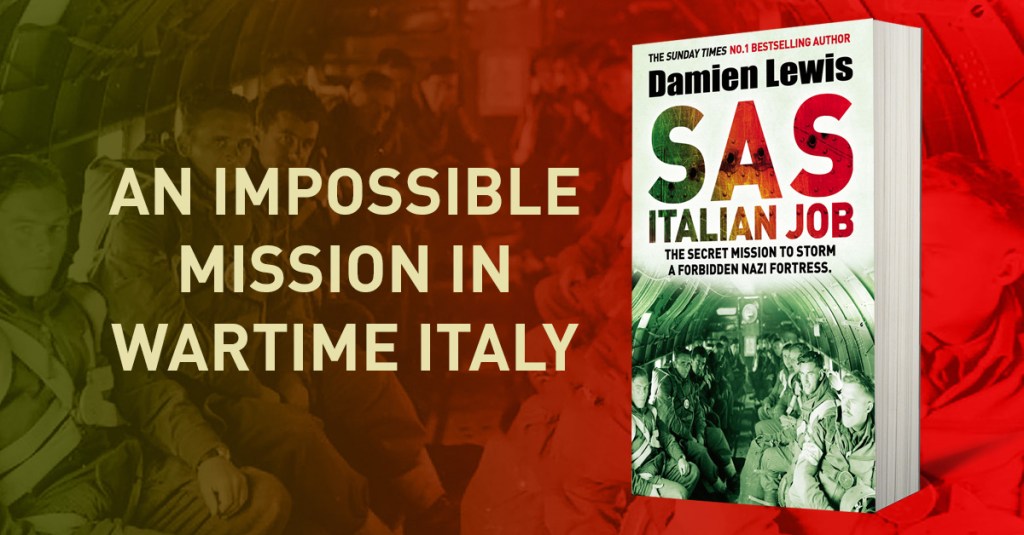Decorated SOE Major betrayed by political infighting by Damien Lewis

Caused his untimely death and the defeat of one of Italy’s most feared band of partisans.
In a quiet yet picturesque commonwealth war cemetery in Genoa, Italy, lies a man who lived an adventurer’s life. His headstone portrays nothing of his exploits, the name carved on it isn’t the one he was known by during the war, and the regimental badge thereon obscures the elite ‘Special Duty’ unit to which he really belonged. The dedication at the bottom of the headstone – “In proud and affectionate memory of a gallant soldier” – goes some way to giving this exceptional man due credit for his secret exploits during the war years.
To the five hundred men and women of the Italian partisan unit he commanded, he was known only as “Major Temple”, TEMPLE being his codename in the Special Operations Executive (SOE), Churchill’s shadowy ‘Ministry for Ungentlemanly Warfare.’ But to his parents, Polish-born Herman Darewski, a famous music hall musician of the time, and the English actress Madge Temple, he was known as Neville Lawrence Darewski. It was from his mother’s maiden name that he’d taken his distinctive nom de guerre.
Major Darewski was comparatively long in the tooth for an SOE operative. The thirty-year-old had found life in the Royal Army Ordinance Corps an ill fit, and he’d volunteered to join the ranks of the Special Operations Executive, following which he was dropped behind the lines in Italy, in 1943. There, he linked up with the fledgling partisans, living a life of extreme danger, hiding his existence from the enemy.
For long months Major Darewski found himself, ‘only moving at night . . . minimum of smoke from fires, kit always ready for immediate move . . . I covered some one thousand miles on foot carrying my kit and arms . . . We had to cross rivers, roads and railways all held by the Germans . . . in small, very mobile parties . . .’
Living on his nerves, always worrying about being denounced by fascist sympathisers, the September 1943 signing of the Italian Armistice, in which the Italians joined forces with the Allies, was music to Major Darewski’s ears. Not one to rest on his laurels, he seized advantage of the confusion immediately following the Armistice, seeking to do as much damage to the German enemy as possible.
He led his band of fighters to strike at a major airbase lying just to the rear of the Gothic Line, Nazi Germany’s supposedly impregnable last line of defence in Italy, a series of bunkers, gun-emplacements, barbed wire and minefields strung across the height of the Apennine Mountains. It was a daring mission that would prove spectacularly successful.
‘We surrounded the airfield and held it for long enough to destroy eighty-nine Italian planes on the ground, and all the hangars and buildings,’ Temple reported. Then with characteristic flair: ‘We flew away one CR.42 to start the Partisan Air Force . . .’ The CR.42 was an Italian Air Force bi-plane, one with an enviable service record and kill ratio.
Not many WWII secret agents could credit themselves with having raised an air wing in enemy territory. It took nerves of steel and real dash to attack an airfield held by seasoned troops with his force of lightly armed and irregular partisans. It also took real foresight to see that even a single aircraft would be a valuable weapon, and was far better than none, especially as Darewski had his partisans busy building an airstrip in the comparative safety of the mountains.
But that pitched battle for the airfield brought Darewski and his forces to the attention of the Germans, who decided to attempt to snuff out this spirited rebellion behind their lines. Darewski had returned to the hills and set about inflicting maximum hurt on the enemy. The Germans might hold the population centres, but out in the countryside they were entering bandit territory and faced the threat of ambush at every turn.
‘The Hun got very annoyed and threatened the direst of penalties to anyone caught doing this,’ Darewski pointed out, which only served to encourage him. From his mountain stronghold – from where there were views all the way to Turin – Darewski planned and executed his operations, all the time supplied by air from the SOE’s Italian headquarters. He proved a real thorn in the side of the local German commander, as his 500 strong partisan force operated to their full potential.
But Operation FLAP, as his mission was ironically named – no one was likely to get a ‘flap-on’ with Major TEMPLE in command – was not to last. Darewski’s downfall – and that of Operation FLAP in its entirety – was to come in November 1944, and it wasn’t due mostly to the enemy. Mercenary back room manoeuvring in Italy and London would have a major hand in his and FLAP’s demise.
The supplies that Darewski had been receiving started to dry up. Drops of weaponry and ammunition that he relied upon began to dwindle. When he requested more he found himself fobbed off. Little did Darewski know that Allied policy dictated from on high was changing when it came to arming “left leaning” partisans. London was increasingly unsure as to which side of the political spectrum the Italian irregulars would come down on at the end of hostilities. Simply put, Whitehall didn’t want a lot of heavily armed Italian ‘communists’ to contend with, after they had finished with the Nazis.
Many of the Italian partisans were nominally ‘communist’. But to Major Darewski they were also die-hard anti-Nazis intent on driving the German enemy out of Italy once and for all. The supplies he requested were all that were keeping him and his men alive, in a war against an increasingly desperate enemy. Yet Whitehall seemed to have little issue with leaving him – and his partisans – hanging out to dry, as the air-drops failed to materialise.
Bereft of re-supplies, and unable to hold the enemy at bay, German patrols managed to penetrate Darewski’s lines and surround his headquarters. On 15 November 1944, packing what few supplies remained onto a truck, Darewski and his core commanders hoped to escape the encirclement. But a simple twist of fate saw the premature and tragic end to this exemplary of SOE commanders. Whilst boarding the truck to escape, his driver lost control and in doing so crushed Darewski against a wall. With numerous injuries there was little his comrades could do for him, and he died soon afterwards.
His death was reported by radio to headquarters, by his W/T operator, a dour Lancastrian former coal-miner called Bert Farrimond. Darewski had been evacuating his headquarters, as the enemy executed a fierce sweep of the valley. Never one for hyperbole, Farrimond reported that ‘everything went wrong, catastrophe overtook us, the Major receiving fatal injuries in the accident.’ Within forty-eight hours Farrimond had been pulled out by air. ‘With the Major gone the mission was finished, so to this end . . . I came out with eleven others in a bomber . . .’
Major Darewski’s death was the worst kind in war, in that it was wholly avoidable. Accidents happen, but had he been supplied with weaponry to keep the enemy at bay, as he’d repeatedly asked for, then he would never would have found himself having to flee. Instead, and as he had promised, he could have gone on to inflict maximum pain on the German garrisons, binding their forces to his area. His death freed them up to finish off his remaining partisans, and from there to advance and cause the deaths of British, American and allied soldiers on the front line. Betrayal at the stroke of a pen back in London had also cost the Darewskis their son, and his wife a husband.
If you ever find yourself in Staglieno Cemetery, Genoa, pay a visit to the grave marked simply: ‘Major Darewski, Neville Lawrence Temple, of the Royal Army Ordinance Corps who died on the 15th of November 1944.’ You’ll know the truth behind his heroic deeds and his sad end that the simple headstone does not portray.







